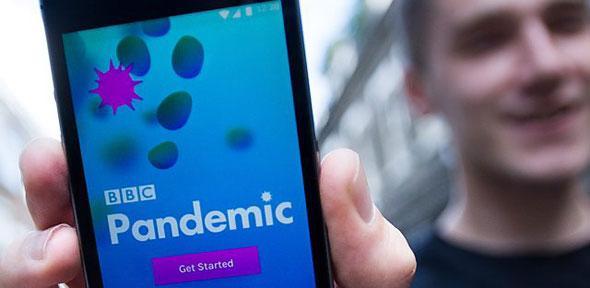
An influenza pandemic is still one of the greatest threats to humanity. During the pandemic in 2009 over 60 million people caught the H1N1 influenza virus in the United States: over 274,000 of these required hospital and, sadly, over 12,000 people died. A groundbreaking project allows every person in the UK to contribute to research to combat future pandemics.
Julia Gog, Professor of Mathematical Biology in the Department of Applied Mathematics and Theoretical Physics, and her team are working with the BBC on an innovative project, BBC Pandemic, combining outreach, citizen science and new mathematical research.
We don't think any other studies will be comparable to this one, and certainly not in the UK. Julia Gog
"Our motivation for doing this is to build better models for [disease] spread in the UK," says Gog. Any UK resident can contribute to the data collection via the BBC Pandemic app on their smartphone (via the App Store or Google Play).
"The immediate outcome will be running some simulations of pandemics for a programme for BBC 4, which will be broadcast in early 2018," says Gog "But the other part is we will be collecting the data so we can study it, and [the data] will be available to other scientists. The point is to understand how people move, as we want to make better models for pandemics and other infectious disease [outbreaks] in the UK."
Spreading disease
When modelling how a disease spreads, says Gog, you want your models to be tractable, and simple enough so you can understand what's gone into them. "But the temptation is just to put in more and more detail, and then you've got to model how everyone moves."
Instead it's easier to use models that are more transparent, and that you can simulate quickly and repeatedly. "The project we have been working on for the last few years is based on [data] from the 2009 pandemic of an influenza-like illness in the US." Here, rather than modelling how the disease spreads between individuals in the population, Gog and her colleagues model how diseases spread between larger units representing cities, towns or villages. These models are based on movement between these city (or town or village) units, which depend on the distance between them, their size and their proximity to other large cities.
Gog and her colleagues have been using the data on how the 2009 pandemic spread to infer the movement patterns between city units. This is because there are not many data sets that specifically gather this movement data. Those that do exist, some collected by apps and some by surveys, are not on the scale the BBC Pandemic project promises and do not connect the information in this way. "We don't think any other studies will be comparable to this one, and certainly not in the UK."
Spreading knowledge
"The big one for us is that this data set will be available to all scientists. I don't know anything like it," says Gog. "They can have all of it!" Thanks to the careful way the data is collected, anonymised and shared, and the permissions for its use that are gathered through the app, it will be the first time such a data set will be made available like this. There is already a great deal of interest from other scientists who were not expecting to have such access to the data. Early on in the project Gog and her colleagues will write a paper to show how the data was gathered, how it is valid, and to encourage other scientists to use the BBC Pandemic dataset.
The scale and public visibility of this project, thanks to the collaboration with the BBC, is extraordinary, but it's not the first time Gog has enabled ordinary members of the public to become active contributors to scientific research. "Putting together outreach and basic science is pretty unusual but we've done it before, so we had evidence it would work," says Gog. This was work with Millennium Mathematics Project's Motivate programme, where Gog and colleagues worked with secondary school students who visited collaborating primary schools and gathered data on social networks within the classes.
"It was primarily about outreach, and secondarily about gathering a beautiful dataset, and both flew." The papers on the Motivate dataset, regularly referred to in the literature, provide data that shows how social mixing patterns in schools change with age and gender. The Motivate project also involved Andrew Conlan (now at the University of Cambridge's Department of Veterinary Medicine) and Adam Kucharski (now at the London School of Hygiene and Tropical Medicine), who were respectively a postdoc and PhD student in Gog's Disease Dynamics research group in DAMTP at the time, and are now both also part of the BBC Pandemic research team.
"The team is a little bit of a DAMTP home team," says Gog, as all the researchers involved in the BBC Pandemic project are current or former members of DAMTP. In addition to Gog, Conlan and Kucharski, the research team comprises another former DAMTP postdoc, Petra Klepac, and two other current members of DAMTP: Stephen Kissler, who is about to take up a research position after finishing his PhD, and graduate student Maria Tang who has just started her PhD.
It is inevitable that another pandemic will strike, and research like this will help governments decide the best response, whether it is closing schools or issuing vaccines. And through innovative projects like this one at DAMTP, everyone can help fight the threat posed by influenza and other highly infectious diseases.
